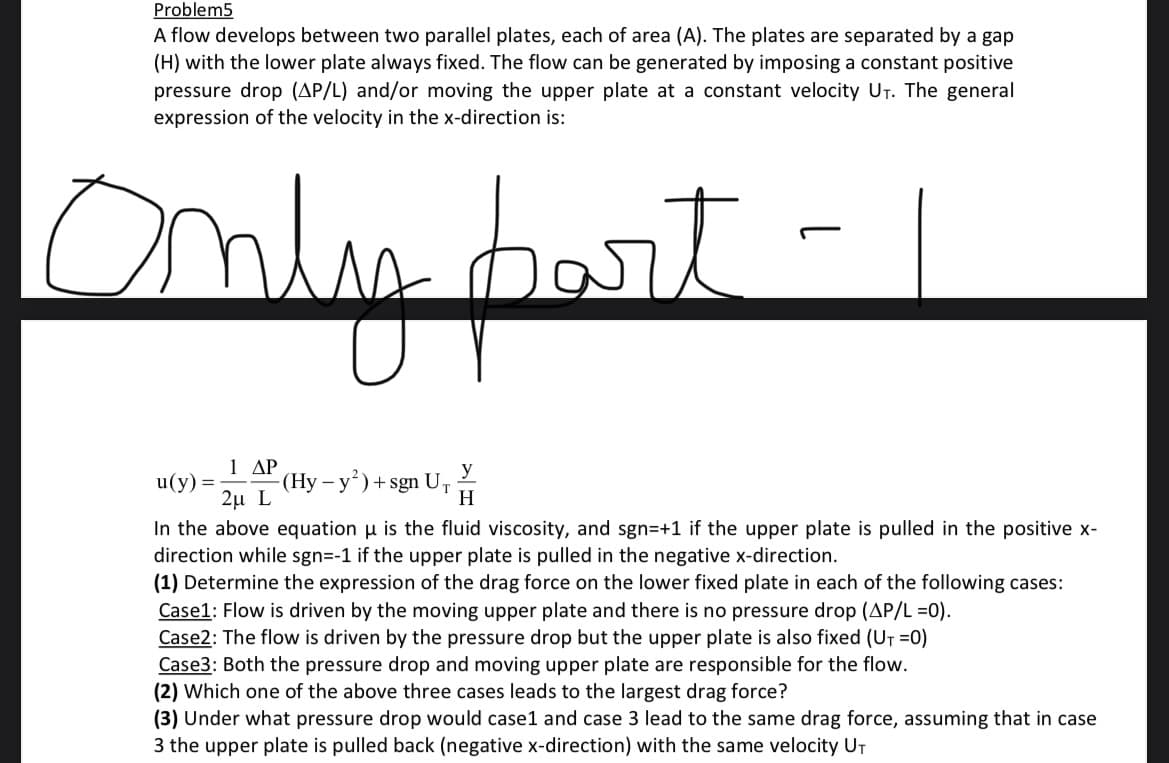A flow develops between two parallel plates, each of area (A). The plates are separated by a gap (H) with the lower plate always fixed. The flow can be generated by imposing a constant positive pressure drop (AP/L) and/or moving the upper plate at a constant velocity UT. The general expression of the velocity in the x-direction is: Only part ΔΡ 2μ L In the above equation u is the fluid viscosity, and sgn=+1 if the upper plate is pulled in the positive x- direction while sgn=-1 if the upper plate is pulled in the negative x-direction. (1) Determine the expression of the drag force on the lower fixed plate in each of the following cases: Case1: Flow is driven by the moving upper plate and there is no pressure drop (AP/L =0). Case2: The flow is driven by the pressure drop but the upper plate is also fixed (U₁=0) Case3: Both the pressure drop and moving upper plate are responsible for the flow. u(y) = 1 (Hy-y²)+sgn UT y H
A flow develops between two parallel plates, each of area (A). The plates are separated by a gap (H) with the lower plate always fixed. The flow can be generated by imposing a constant positive pressure drop (AP/L) and/or moving the upper plate at a constant velocity UT. The general expression of the velocity in the x-direction is: Only part ΔΡ 2μ L In the above equation u is the fluid viscosity, and sgn=+1 if the upper plate is pulled in the positive x- direction while sgn=-1 if the upper plate is pulled in the negative x-direction. (1) Determine the expression of the drag force on the lower fixed plate in each of the following cases: Case1: Flow is driven by the moving upper plate and there is no pressure drop (AP/L =0). Case2: The flow is driven by the pressure drop but the upper plate is also fixed (U₁=0) Case3: Both the pressure drop and moving upper plate are responsible for the flow. u(y) = 1 (Hy-y²)+sgn UT y H
Principles of Heat Transfer (Activate Learning with these NEW titles from Engineering!)
8th Edition
ISBN:9781305387102
Author:Kreith, Frank; Manglik, Raj M.
Publisher:Kreith, Frank; Manglik, Raj M.
Chapter5: Analysis Of Convection Heat Transfer
Section: Chapter Questions
Problem 5.37P
Related questions
Question

Transcribed Image Text:Problem5
A flow develops between two parallel plates, each of area (A). The plates are separated by a gap
(H) with the lower plate always fixed. The flow can be generated by imposing a constant positive
pressure drop (AP/L) and/or moving the upper plate at a constant velocity UT. The general
expression of the velocity in the x-direction is:
Only part
1 ΔΡ
u(y) = -(Hy - y²) + sgn U₁
2μ L
In the above equation is the fluid viscosity, and sgn=+1 if the upper plate is pulled in the positive x-
direction while sgn=-1 if the upper plate is pulled in the negative x-direction.
(1) Determine the expression of the drag force on the lower fixed plate in each of the following cases:
y
H
Case1: Flow is driven by the moving upper plate and there is no pressure drop (AP/L =0).
Case2: The flow is driven by the pressure drop but the upper plate is also fixed (U₁=0)
Case3: Both the pressure drop and moving upper plate are responsible for the flow.
(2) Which one of the above three cases leads to the largest drag force?
(3) Under what pressure drop would case1 and case 3 lead to the same drag force, assuming that in case
3 the upper plate is pulled back (negative x-direction) with the same velocity UT
Expert Solution
This question has been solved!
Explore an expertly crafted, step-by-step solution for a thorough understanding of key concepts.
Step by step
Solved in 3 steps

Knowledge Booster
Learn more about
Need a deep-dive on the concept behind this application? Look no further. Learn more about this topic, mechanical-engineering and related others by exploring similar questions and additional content below.Recommended textbooks for you

Principles of Heat Transfer (Activate Learning wi…
Mechanical Engineering
ISBN:
9781305387102
Author:
Kreith, Frank; Manglik, Raj M.
Publisher:
Cengage Learning

Principles of Heat Transfer (Activate Learning wi…
Mechanical Engineering
ISBN:
9781305387102
Author:
Kreith, Frank; Manglik, Raj M.
Publisher:
Cengage Learning